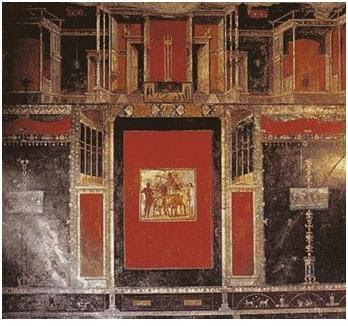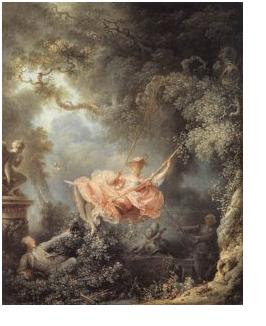The Domestic Interior--Roman Painting, Rococo, and Matisse
Since the beginning of human existence, people have required shelter. This fact has not changed, though the way people choose to adorn their domestic surroundings certainly has. Decorating one’s home to reflect personal i
nterests, for the purpose of entertaining or doing business, or to display wealth and power is a practice that dates back to the beginning of civilization. This post will contrast some examples of various artistic movements that have contributed to the way we construct our interior environments.
Roman Painting—Four Styles of Wall Décor
Roman homes were constructed with the specific needs of the owners in mind. Certain rooms were designated for business meetings, others were for entertaining. The paintings that adorned the walls of Roman homes developed over the course of centuries. The paintings are categorized into four styles, which correspond to the dates at which they were popular. The main factors that distinguish the styles are levels of ornament, perspective, and human presence.
First Style painting
Our knowledge of Roman Painting largely comes from the remarkable amount of stunning artifacts that were preserved by the volcanic eruption of Mount Vesuvius in Pompeii in 79 AD. When the volcano erupted, it completed smothered the Roman city with volcanic ash, completely preserving the city and providing us with an unparalleled tool for the study of ancient times. Thanks to the homes preserved in Pompeii, many examples of Roman painting styles can be observed today, allowing scholars access to information about the way ancient Roman citizens lived that might have otherwise been unavailable.
Fourth Style painting
Rococo
In 18th century France, the Rococo movement reinvented many aspects of Roman Interiors. The arabesque is one type of depiction in particular that was inspired by Roman Painting, but features more elaborate and ornate displays of wealth in a Baroque fashion. The term arabesque refers to a decorative scene painted on panels built into the walls of a home. The scenes usually feature aristocratic characters, often engaged in leisure activities. The narratives are then surrounded with organic patterns that mirror the second style of Roman painting. Where Roman paintings used renderings of fabric or organic material to frame painted scenes, Rococo interiors boasted gold leaf and relief sculpture. The paintings of the Baroque period were equally ornate. Francois Boucher depicted scenes of robust nudes in lush organic settings, with light color palettes made up primarily of pinks and other pastels. Jean-Honore Fragonard was famous for portraits with a distinctly quick and expressive brushstroke. He also painted vibrant landscape scenes with organic environments that seemed to have a life of their own. One example is his famous piece entitled The Swing, pictured below. Like arabesques, The Swing features an aristocratic scene of leisure.
Matisse
One of the great modern masters specialized in unique portrayals of interior spaces, namely Henri Matisse. As a post-impressionist, specifically a Fauvist, Matisse used vibrant color palettes and focused more on surface rendering than perspective. His famous piece entitled “Harmony in Red (Red Room)” features a continuous pattern that stretches across both the surface of the table cloth and the interior’s walls.

MIR Appraisal Services, Inc. is a fine art and antiques appraisal company that places a premium on research and client satisfaction. Employing a team of experts knowledgeable in various fine arts objects, MIR’s employees go the extra mile and dig deep into the interesting histories of the pieces brought to their attention by clients. Far from just giving an accurate monetary appraisal MIR offers clients true insight into the deeper value of their treasured items.
MIR Appraisal Services, Inc.
Principal Appraiser: Farhad Radfar, ISA AM
307 N. Michigan Avenue, Suite 308
Chicago, IL 60601
(312) 814-8510









